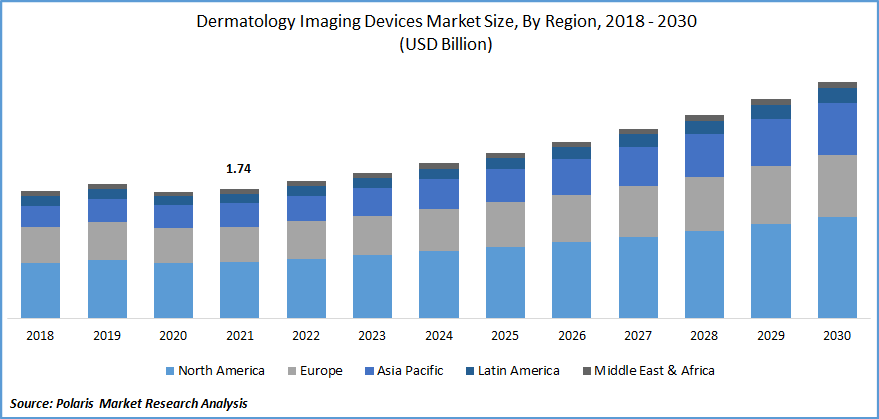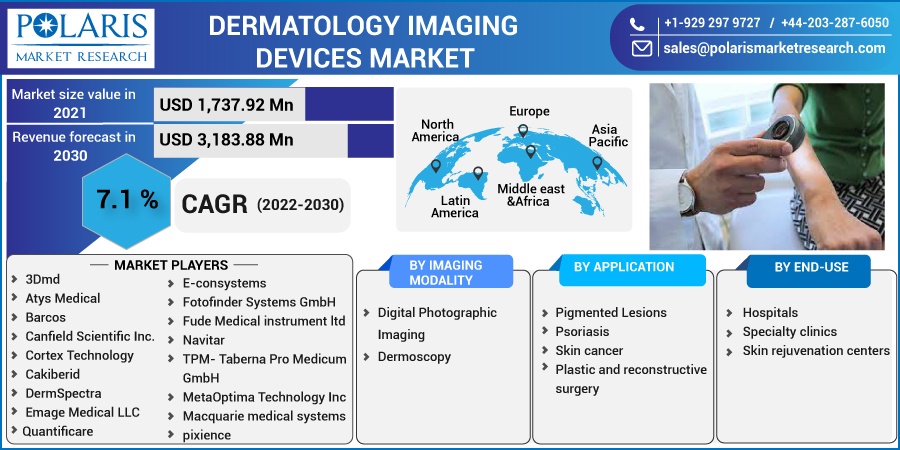
Dermatology Imaging Devices Market Share, Size, Trends, Industry Analysis Report, By Imaging Modality (Digital Photographic Imaging, Dermoscopy); By Application (Pigmented Lesions, Psoriasis, Skin Cancer); By End-Use; By Region; Segment Forecast, 2022 - 2030
- Published Date:Sep-2022
- Pages: 112
- Format: PDF
- Report ID: PM2585
- Base Year: 2021
- Historical Data: 2018-2020
Report Outlook
The global dermatology imaging devices market was valued at 1,737.92 million in 2021 and is expected to grow at a CAGR of 7.1% during the forecast period. The growing demand for the dermatology imaging devices market is rising, primarily for high-risk patient monitoring and documenting disease conditions.

Know more about this report: Request for sample pages
The ease of availability of smartphones which allows capturing an image of the lesions, and handheld cameras with high-resolution transcripts of the image into a document of the patient condition are the new technologies that have driven the growth of the industry. Moreover, the rise in skin cancer needs huge attention to develop new equipment and technologies to cure the illness.
The COVID-19 pandemic has negatively impacted the growth of the dermatology imaging devices market during the initial phase of lockdown. It has affected the supply chains and hampered the equipment required for the dermatology tomography process. Improper treatment regimens, lack of dermatology patient compliance, and improper monitoring also impacted the industry.
As there is a rise in awareness about the product available for grooming, there has been a rise in demand for acne, psoriasis, and lesion treatment. So growing need for tools like dermatoscopes and photography tomography devices can significantly drive the industry's growth in the forecast period.
 Know more about this report: Request for sample pages
Know more about this report: Request for sample pages
Industry Dynamics
Growth Drivers
The global dermatology imaging devices market is likely to be driven due to the highly visual nature of skin diseases. The growth is also expected because of new technologies where dermatology imaging devices make it possible to capture and describe the disorder in written form, which is helpful for dermatologists and patients.
In addition, non-invasive methods have become popular in diagnosing skin diseases in recent years, which is expected to drive the industry. The growing demand for better products in the dermatology tomography devices industry offers manufacturers many growth opportunities. Moreover, increasing disposable income, where consumers tend to invest in improving their appearance, can also drive market growth.
Technology-advanced tools are increasingly being used than traditional ones, which helps to diagnose skin diseases better. The emergence of cutting-edge technology has improved and led to many beauty enhancements that can support the market's growth.
Report Segmentation
The market is primarily segmented based on imaging modality, application, end-use, and region.
|
By Imaging Modality |
By Application |
By End-Use |
By Region |
|
|
|
|
Know more about this report: Request for sample pages
Dermoscopy segment accounted for the largest share in 2021
The dermoscopy imaging modality segment accounted for the highest revenue share in 2021 owing to the fact it diagnoses skin lesions ten times with the devices and covers a deep range of the lesions. In addition, both pigmented and non-pigmented skin illnesses could be detected and diagnosed with improved accuracy and sensitivity, which is expected to propel the market's growth.
Digital photographic tomography also contributed to revenue growth but captured a less targeted audience, as a consumer needs to know the deep cause of any illness. Where this particular segment is inexpensive and requires easy management but only captures the skin lesions which could be seen by unaided eyes.
Skin cancer is expected to spearhead the market growth
The demand for skin cancer is driven by the rising number of patients diagnosed with skin cancer. Ultrasound dermatology tomography devices are used to treat such cancer, depending upon whether it is benign or malignant. It is the most effective way to treat skin cancer owing that it targets the tumor, and the laser can be precise at that particular position.
Pigmented lesions are also expected to grow over the coming years. With innovative new technologies, 2D & 3D whole body dermatology devices are used to detect pigmented lesions in the entire body and every part of the body. The whole-body dermatology tomography devices provide rapid documents about lesions and accurate analysis of the suspicious lesion, which can drive market growth.
The hospital segment is expected to account for the largest share in 2030
The hospital segment is expected to dominate the market over the forecast period owing to the increasing innovation and advancement in dermatology devices. Moreover, the availability of many treatments at hospitals has increased the number of visits for various skin diseases, which eventually supports the segment's growth.
Specialty Clinics are expected to be one of the other segments that can grow over the forecast period because they focus on particular skin diseases for rapid and effective services.
Asia Pacific will witness the fastest growth over the forecast period
The Asia Pacific is the largest region for dermatology tomography devices. It is expected to witness faster growth over the forecast period owing to the initiatives taken by many key players investing in research and development, which boost the segment's growth. Rapid consciousness about lesions on the skin and the availability of affordable treatments are the drivers fueling the market's growth.
North America accounted for the largest revenue in the dermatology imaging devices market. It will continue to dominate owing to high healthcare infrastructure, new dermatological equipment to treat skin diseases, and growing concerns about skin cancer and skin illness.
Competitive Insight
Some of the major players operating in the global market include canfield scientific, 3Dmd, Atys Medical, Barcos, Bomtech Electronics Co. Ltd, Canfield Scientific Inc., Cortex Technology, Cakiberid, Courage + Khazaka electronic GmbH, DermSpectra, Emage Medical LLC, E-consystems, Fotofinder Systems GmbH, Fude Medical instrument ltd, Navitar, TPM- Taberna Pro Medicum GmbH, MetaOptima Technology Inc, Macquarie medical systems, pixience, Quantificare.
Recent Developments
In March 2021, Barco announced a partnership with modernizing medicine so that dermatologists can use dermatology imaging devices and innovative technology in their day-to-day practice sessions.
In December 2021, Canfield Scientific, Inc. Acquired Medici Medical s.r.l to carry out innovations in dermoscopy to provide advanced learning in the field of medical imaging.
Dermatology Imaging Devices Market Report Scope
|
Report Attributes |
Details |
|
Market size value in 2021 |
USD 1,737.92 million |
|
Revenue forecast in 2030 |
USD 3,183.88 million |
|
CAGR |
7.1% from 2022 - 2030 |
|
Base year |
2021 |
|
Historical data |
2018 - 2020 |
|
Forecast period |
2022 - 2030 |
|
Quantitative units |
Revenue in USD billion and CAGR from 2022 to 2030 |
|
Segments covered |
By Imaging Modality, By Application, By End-use, By Region |
|
Regional scope |
North America, Europe, Asia Pacific, Latin America; Middle East & Africa |
|
Key companies |
3Dmd, Atys Medical, Barcos, Bomtech Electronics Co. Ltd, Canfield Scientific Inc., Cortex Technology, Cakiberid, Courage + Khazaka electronic GmbH, DermSpectra, Emage Medical LLC, E-consystems, Fotofinder Systems GmbH, Fude Medical instrument ltd, Navitar, TPM- Taberna Pro Medicum GmbH, MetaOptima Technology Inc, Macquarie medical systems, pixience, Quantificare |
